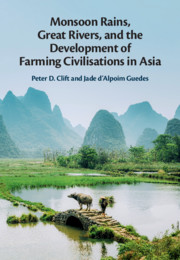Book contents
- Monsoon Rains, Great Rivers, and the Development of Farming Civilizations in Asia
- Monsoon Rains, Great Rivers, and the Development of Farming Civilizations in Asia
- Copyright page
- Contents
- Acknowledgments
- 1 Introduction
- 2 Temporal Variations in the Asian Monsoon
- 3 Monsoon and Societies in Southwest Asia
- 4 Origins of a Uniquely Adaptive Farming System:
- 5 Dryland Farming in the Northern Monsoon Frontier
- 6 Recent Changes in Monsoon Climate
- 7 Future Monsoon Predictions
- References
- Index
7 - Future Monsoon Predictions
Published online by Cambridge University Press: 17 December 2020
- Monsoon Rains, Great Rivers, and the Development of Farming Civilizations in Asia
- Monsoon Rains, Great Rivers, and the Development of Farming Civilizations in Asia
- Copyright page
- Contents
- Acknowledgments
- 1 Introduction
- 2 Temporal Variations in the Asian Monsoon
- 3 Monsoon and Societies in Southwest Asia
- 4 Origins of a Uniquely Adaptive Farming System:
- 5 Dryland Farming in the Northern Monsoon Frontier
- 6 Recent Changes in Monsoon Climate
- 7 Future Monsoon Predictions
- References
- Index
Summary
Summer monsoon rainfall is controlled by a number of factors but in general it is expected to intensify as the Earth becomes warmer. Rainfall is expected to be higher in South Asia, with the exception of Northwest India and Pakistan where drying is predicted. The Indian monsoon will be more prone to significant breaks. More cyclones are expected to make landfall in the Arabian Sea, while in East Asia typhoons will affect eastern China more. Rainfall is not expected to change greatly in China, but higher temperatures will result in more frequent drought especially in North China and the Tibetan Plateau where warming is strongest. Pollution will reduce rainfall, counteracting the effect of higher temperatures. Traditional small-scale farming is more effective at retaining soil moisture and may be more appropriate than large industrial agriculture in coping with the anticipated environmental changes. Sea-level rise is expected to rise approximately 36 cm by 2100, even assuming that CO2 emissions are capped. These rises are expected to more than double the occurrence of major tidal flooding, placing millions of people in jeopardy by the end of the century, especially in Bangladesh and Vietnam.
- Type
- Chapter
- Information
- Publisher: Cambridge University PressPrint publication year: 2021



